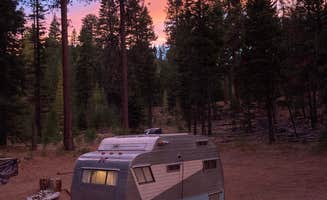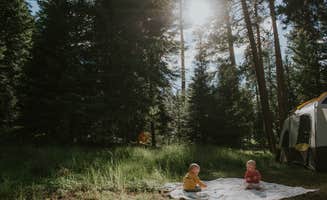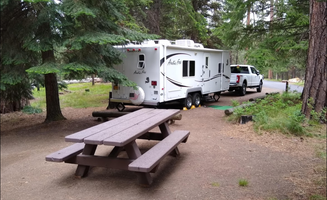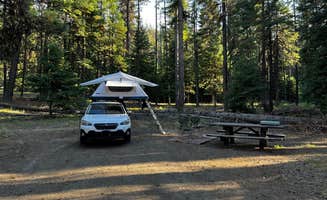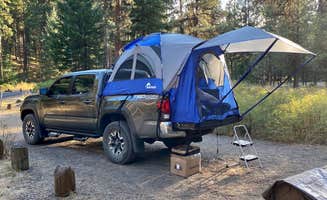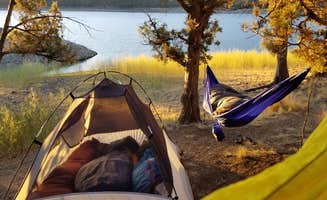Central Oregon campsites range from high-elevation locations at over 4,700 feet to riverside spots along the John Day River. Seasonal temperature variations can be extreme, with summer daytime highs reaching the 80s while nighttime temperatures often drop to the 40s even in July. Most dispersed camping areas in the Ochoco National Forest require visitors to bring their own water and pack out all waste.
What to do
Fishing opportunities: Prineville Reservoir State Park offers excellent fishing for various species. The reservoir is stocked with trout and has natural populations of crappie. "Nice place to launch a boat and fish or tube. Has an amazingly helpful fish cleaning space! Can even catch fish off the bay," notes Sarah W. The park features a dedicated fish cleaning station constructed with local juniper trees.
Hiking trails: Multiple short trails provide views of geological formations. Many campgrounds connect directly to trail systems of varying difficulty. At Barnhouse Campground, visitors can access trails right from their site. "There was a trail and creek nearby with a trough to fill up water - I'd recommend filtering before drinking," advises Kristina J. The campground offers easy access to the nearby Painted Hills with trails showcasing the colorful geological features.
Swimming and water recreation: Several lakes provide summer swimming options. Water temperatures vary significantly by location and season. One visitor at Ochoco Lake County Park noted: "Great sites and great host! Easy to get to lake from the campground and very peaceful!" The lake permits kayaking, canoeing and "slower boating" according to Christopher C.
What campers like
Wildlife viewing: Early mornings and evenings offer the best opportunities. Campers regularly report seeing deer, various bird species, and occasionally coyotes. "During the week late summer, Huge full moon, then the coyotes began to yip/howl..magnificent," describes Kevin R. about his experience at Ochoco Divide Campground.
Stargazing: Several campgrounds offer exceptional night sky viewing. The high elevation and minimal light pollution create ideal conditions. "This is also a dark sky park and if the moon is not bright the stars are amazing," reports Amy B. about Prineville Reservoir. The best viewing is typically between June and September when skies tend to be clearest.
Solitude: Many dispersed camping areas offer significant privacy. Locations farther from paved roads typically provide the most isolation. At Painted Hills Dispersed camping area, one camper noted: "I arrived midday, so I spent the hottest part of the day in my shade tent reading and then in the evening watched the fire under the stars in my hammock. Very peaceful, only saw one car drive by the whole time."
What you should know
Road conditions: Access varies significantly by season and location. Many forest service roads become impassable after rain or snow. "The dirt road to the campsite is bumpy and rutted but I made it just fine with my Tacoma and off-road trailer. I wouldn't trust the road in the rain, it looks like it turns into a mud pit," warns a camper about Painted Hills Dispersed camping area.
Bathroom facilities: Standards vary widely between established and dispersed camping. Most established campgrounds have vault toilets at minimum, while dispersed camping areas have none. At Barnhouse Campground, "Clean toilet when we were there," reports Andrew S., though he notes some sites have a "slight slant so we needed a couple of leveling blocks."
Water availability: Many campgrounds lack reliable water sources. Visitors should plan to bring adequate water supplies. At Ochoco Divide Campground, a visitor noted: "The only downside is that there is no water available, so you need to bring all you need."
Tips for camping with families
Choose developed campgrounds with amenities: Facilities make family camping more manageable. Campgrounds with restrooms and drinking water reduce logistical challenges. At Walton Lake Campground, families appreciate the facilities and activities: "My boys loved riding their bikes around the campground (which is small enough that you can see them even if they are on the other side of the lake)," notes Amanda B.
Bring insect protection: Bugs can be particularly problematic at dusk. Mosquitoes are common near water sources during summer months. One camper at Ochoco Divide noted, "The mosquitoes were fierce after the sun started to set."
Consider temperature swings: Pack clothing for both warm days and cold nights. At higher elevation campgrounds, nighttime temperatures can drop dramatically. "Camp ground is high up over 4700 feet so even in the summer it tends to get a little chilly at night but not bad," advises Kevin R. about Ochoco Divide Campground.
Tips from RVers
Site selection matters: Many campgrounds have limited level sites. Not all sites accommodate larger vehicles or trailers. Jeff C. shares detailed information about Deep Creek Campground: "Nice big campground 15 spaces and nice space between sites... Good for RV's and tent campers." He notes the campground has "Pit toilets and lots of firewood left at campsites by others."
Generator policies vary: Check regulations before arrival. Some campgrounds restrict generator use to specific hours or prohibit them entirely. At Ochoco Lake County Park, "Since there are no RV services be prepared to hear some generators running occasionally. Quiet hours 10PM-7AM," reports Mark W.
Hookup availability: Most forest service campgrounds lack electric connections. Even established campgrounds often have limited or no hookup services. Cindy S. notes about Barnhouse Campground: "Had no trouble getting our 30 ft Class A in there. Was surprisingly full on a Wednesday when we arrived but was empty on Friday."


